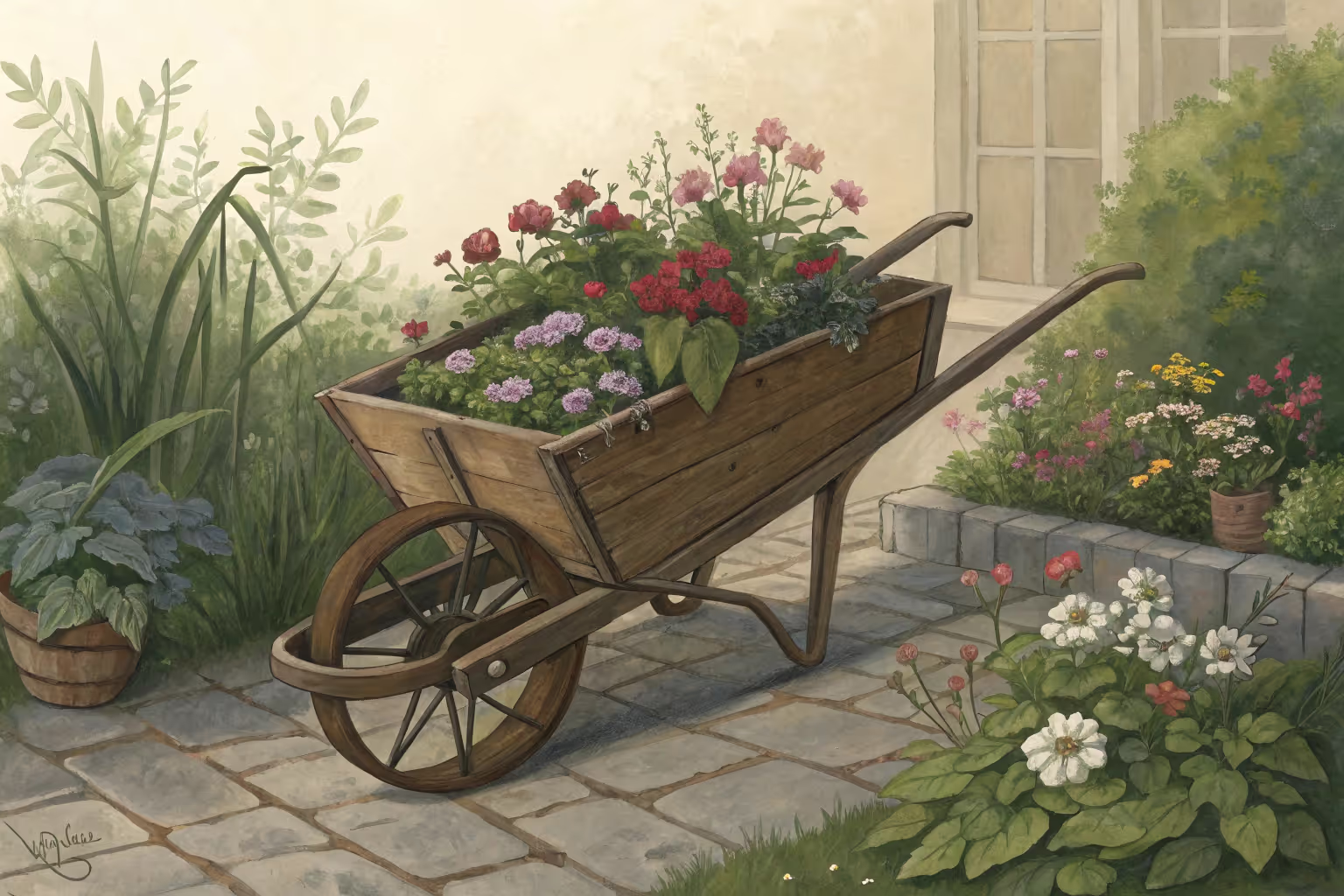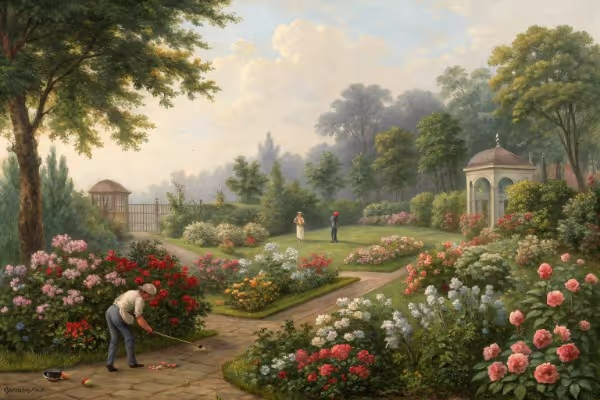Getting the Right Wheelbarrow for Your Garden

Wheelbarrow
Choosing a wheelbarrow sets the rhythm for your gardening flow. A solid wheelbarrow moves compost and mulch without wobble, fits gates and pathways comfortably, and spares your back on steep terrain. Match the right size, tire type, and material to your garden style, and your wheelbarrow becomes a trusted work companion rather than an awkward nuisance—here’s how to pick yours.
Cheatsheet: Pick the Best Wheelbarrow for Garden Wins
🛒 Types & Uses
- Single wheel: Quick turns, better for tight beds
- Two wheel: Stability, reduces wrist strain
- Poly tray: Rustproof, lightweight, lasts 5–8 years
- Steel tray: Handles rocks, lasts 10+ years if stored dry
- Volume: 2–6 cu ft (56–170 L) fits most gardens
- Weight limit: 80–400 lb (36–181 kg)
💪 Ergonomics & Health
- Choose dual handles for grip control
- Pneumatic tires (air-filled) soften impact, protect wrists
- Never overload—saves back & joints
- Wheelbarrows help avoid 60% of common garden lifting injuries
🌱 Self-Sufficiency Gains
- Move soil, mulch, compost in fewer trips
- Reduce fatigue—extend productive hours
- Transport harvests to kitchen faster
🛠️ Tools & Products You’ll Need
- Wheelbarrow matched to your needs
- Air pump (for pneumatic tires)
- Workbench & wrench (for assembly & maintenance)
- WD-40 or similar (for moving metal parts)
- Gardening gloves
🔍 Fast Selection Steps
- Assess garden paths—measure tightest width (add 2 in/5 cm clearance)
- Estimate load weight—pick wheelbarrow capacity accordingly
- Choose tray—poly for light/clean, steel for heavy/rough loads
- Pick tire type—solid for no flats, pneumatic for shock absorption
- Test handle comfort at store if possible
- Store indoors or under cover for longest life
I treat a Wheelbarrow like a partner, because a good one saves your back and your schedule. The right pick depends on load type, terrain, and how often you haul.
Tray volume is listed in cubic feet and liters, and most garden barrows run 4 to 10 cu ft, about 110 to 280 L. For daily work, I reach for 6 cu ft, which covers mulch runs yet still threads narrow gates.
“Mulch weighs 400 to 800 pounds per cubic yard, topsoil about 2,000, and gravel around 2,700.” University of Missouri Extension, Materials Calculator
Translate that to per cu ft and your barrow’s story gets real fast. A level 6 cu ft load is roughly 90 to 180 lb of mulch, about 440 lb of topsoil, or near 600 lb of gravel.
Single wheel turns on a dime and dumps cleanly, which is gold in tight beds and winding paths. Two wheels track straighter and feel steadier with firewood or pavers, though they fight ruts and curbs.
Four wheel garden carts carry bulk with ease on firm ground, yet stall in mud and on slopes. I run a single wheel in the orchard where grades hit 8 percent and a twin wheel on the flat pad behind the shed.
Pneumatic tires ride soft and grip well, but they need air checks at 25 to 35 psi, 1.7 to 2.4 bar. Flat free polyurethane tires never go soft and suit thorny hedges, though they bounce on gravel and transmit vibration.
Pick 16 inch wheels, about 406 mm, for easier rolling over roots and curbs. Ask for sealed ball bearings with grease fittings, since bushings wear fast under wet loads.
Powder coated steel feels planted and shrugs off abrasion from stone, yet it will rust if you park it wet. UV stabilized poly weighs less and laughs at fertilizer salts and manure teas, but sharp rubble can gouge it.
Concrete crews love steel because the lime scours poly over time. I rinse cement splatter before it sets and wipe the tray dry, which keeps a contractor barrow alive for years.
Ash or hickory handles warm in the hand and dampen shock, while steel tubes pull weight closer to your hips for stronger lifts. Loop handles turn easily in tight corners and help with one handed tweaks near seedlings.
Set handle height near your hip crest and keep elbows a little bent. That lines the load with your skeleton so your muscles do less theatrics.
“Under ideal conditions, the recommended weight limit is 51 pounds.” NIOSH Revised Lifting Equation, CDC
I still move heavier stuff, only in smaller bites and with the load pushed forward over the wheel. Short runs, more trips, fewer regrets.
Park the heavy mass over the axle to shrink the lift. For mulch, I heap slightly rearward so the tray tips without a fight at the bed edge.
Look for replaceable skid shoes under the legs and a welded front bumper. Those two parts take the beating year after year.
- Contractor steel 6 cu ft, single wheel: Jackson M6 style or Bon 6 cu ft. Stiff tray, stout legs, 16 in pneumatic tire, about 50 to 75 lb empty, 150 to 220 USD, 140 to 200 EUR.
- Lightweight poly 6 or 8 cu ft, single wheel: True Temper or Haemmerlin 90 L in the EU. Less rust grief, easier lifts for fine compost, 120 to 220 USD, 110 to 200 EUR.
- Two wheel 8 cu ft poly or steel: Rubbermaid Big Wheel or Pro models. Stable with firewood or blocks, slower to pivot in beds, 180 to 350 USD, 170 to 330 EUR.
- Flat free conversion: Swap a 4.80 or 4.00 by 8 tire to flat free for thorny hedges. About 35 to 70 USD per wheel, 30 to 65 EUR.
- EU classic: Fort or Haemmerlin steel 100 L with 16 in tire and sealed bearings. Built for cobbles and curbs, 150 to 260 EUR.
- Spare inner tube and a compact pump, plus a valve core tool.
- Tire sealant for thorn season, light doses to avoid imbalance.
- Grip tape on handles for wet mornings and muddy gloves.
- Grease gun with marine grease for bearings in rainy climates.
- Tray liner for mixing soil blends, then lift it out to clean.
- Weather cover to block UV and keep the tray bone dry.
- Tray volume in cu ft and liters, plus stated load rating in lb and kg.
- Wheel diameter and tire type, ask about bearings and grease points.
- Tray gauge if steel, 16 or 18 gauge beats thin sheet that oil cans.
- Welds at the nose piece and leg braces, look for full beads, no gaps.
- Handle material and fasteners, through bolts with locknuts last longer.
- Warranty in writing and availability of wheels, trays, handles, and legs as parts.
- Overall width to fit gates, many are 25 to 28 in, 64 to 71 cm.
Rinse soil acids and fertilizer salts, then dry the tray before you park it. Wipe wood handles with boiled linseed oil twice a year to keep checks from opening.
Grease bearings every few months and check tire pressure monthly. Hang the barrow by the nose in a shed, which keeps rain out and tires round.
Keep paths graded and clear, and avoid sidehilling over 10 percent slope, about 5.7 degrees. On climbs, lift small loads and pause often, and on descents, stay behind the grips and let the wheel roll, never ride the legs.
Gloves, eye protection, and boots matter when rock or rebar rides in the tray. I quit stacking pavers above grip height after one bad wrist snap in my twenties.
Can a Wheelbarrow mix concrete well? Steel trays handle it, figure a 6 cu ft barrow yields about 3.5 to 4 cu ft of mixed concrete before slop becomes unmanageable, and rinse immediately so the cement does not cure in the corners.
Can a barrow live outside? Yes with a cover and a slight nose up tilt for drainage, though poly can chalk under UV and steel rusts if water sits at the seams.
What size for raised bed paths? A 4 or 5 cu ft narrow body slips through 30 in, 76 cm, paths without bruising kale.
How much should I spend? Quality single wheel rigs land at 120 to 250 USD, 110 to 230 EUR, with pro frames and trays worth the extra if you haul stone or concrete.
- Tray volume: 4 to 10 cu ft, 110 to 280 L.
- Load ratings: 200 to 600 lb, 90 to 270 kg, check the label.
- Wheel size: 13 to 16 in, 330 to 406 mm, larger rolls easier.
- Tire pressure: 25 to 35 psi, 1.7 to 2.4 bar for pneumatic.
- Steel tray gauge: 16 to 18 is durable for gravel and block.
- Overall width: 25 to 28 in, 64 to 71 cm for standard gates.
Local pro supply yards stock heavier frames and can order parts, while big box stores offer workable value and easy returns. In the aisle, lift and turn a floor model, then roll it loaded with two bags of compost to feel the balance.
Ask about wheel warranties, spare handles, and tray replacements, and confirm assembly is included in the price. I mark the purchase date under the tray lip with a paint pen for warranty claims later.
University of Missouri Extension, Materials Calculator and Bulk Material Weights. CDC NIOSH, Revised Lifting Equation. Royal Horticultural Society, advice pages on moving loads and tool selection. Personal field notes from installing patios, orchard work on 8 percent grades, and weekly mulch runs for public beds since the late 1990s.

Want smarter plant choices? 🪴
Wheelbarrow Wisdom: Frequently Asked Questions
What wheel type best suits garden terrain?
For uneven or soft soil, a wheelbarrow boasting pneumatic, air-filled tires glides smoothly, absorbing shocks and floating lightly over mulch or mud. Conversely, solid rubber tires serve faithfully on firm, level surfaces, shrugging off sharp debris and sparing their gardener tedious tire inflation.
Should I choose steel or poly wheelbarrow trays?
A steel tray sings durability and resilience, excelling at hauling rocks, bricks, and heavy soil. But beware—steel's weight and willingness to rust demand constant upkeep. A poly tray, though lighter and resistant to decay, gleefully moves compost and mulch, but quietly protests against sharp or abrasive cargo.
One wheel or two—which offers better control?
A single-wheel wheelbarrow dances gracefully around tight turns and narrow paths with deft maneuverability, yet demands mindful balance under heavy loads. The two-wheeled version offers stability for those unwilling to risk tipping valuable cargo, yet sacrifices nimbleness and agility in confined spaces.
What capacity suits typical garden work?
For common garden tasks—moving compost, soil, mulch—a wheelbarrow capacity between 4 to 6 cubic feet serves admirably without inducing overexertion. For ambitious earth-moving or construction duties, larger capacities may tempt but carry the price of increased physical exertion and unwieldiness.
How should I maintain my wheelbarrow for longevity?
After each day's work, rinse your loyal wheelbarrow thoroughly, removing debris and moisture. A periodic application of linseed oil or rust-inhibiting spray on steel surfaces, proper tire inflation, and occasional bolt-tightening infuse vitality into its lifespan, securing years of steadfast garden companionship.
Pick the right wheelbarrow and you’ll wonder how you ever gardened without it. Size, balance, and material matter—choose something that matches both your terrain and your ambitions. Go too small and you’ll curse every extra trip; too big and it’ll own you, not the other way around. Pneumatic tires for uneven ground, steel trays for heavy loads, poly for lighter work—know your needs. Take care of your gear and it’ll take care of you, season after season. For more on choosing the best tools for your shed, check out this beginner’s guide to gardening tools. The right wheelbarrow doesn’t just move dirt; it keeps your back happy and your garden growing.
The Health Benefits of Gardening with a Wheelbarrow
Strengthen and Tone Muscles
Regular wheelbarrow use activates arm, back, core, and leg muscles. Controlled lifting and pushing builds functional strength and stability without gym workouts.
Enhance Cardiovascular Fitness
Active gardening, including wheelbarrow pushing, improves heart rate and circulation. Moderate gardening tasks burn approximately 250-350 calories per hour.
Protect Joints and Prevent Injuries
A wheelbarrow redistributes weight, reducing stress on knees and back. Proper ergonomics prevent muscle strain and joint overuse.
Boost Mental Wellness
Outdoor physical activity lowers stress hormones and enhances mood and mental clarity. Gardeners experience reduced anxiety and improved sleep quality.
Increase Bone Density Naturally
Weight-bearing tasks with a wheelbarrow promote bone health, aiding osteoporosis prevention without medication.
Optimize Vitamin D Levels
Even brief gardening sessions outdoors in sunlight increase vitamin D production, important for immune and bone health. Aim for at least 15 minutes of exposure several times weekly.
Find out which plants will thrive in your garden!
Answer a few fun questions and get custom plant recommendations perfect for your space. Let’s grow something amazing together!

start your season





